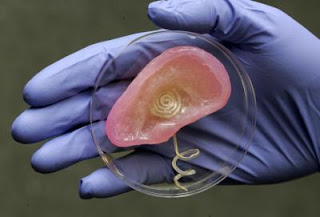MCOR Technologies White Paper: How 3D printing works.
Entertainment:
Last year’s blockbuster sci-fi thriller, Prometheus, owes some of its success to the visionary work of FBFX Ltd, a film industry model company, and to the 3D printers that brought their creations to life.
Set on a, shall we say, unhospitable planet, the characters in Prometheus are constantly wearing spacesuits. While the fabric portions of these spacesuits can be mocked up by costume designers, the high-tech, LED-filled helmets had to be created using 3D models. That job fell to Grant Pearmain, FBFX’s managing director, and his team.
Engineering:
One of the most difficult parts of integrating electronics with biological tissue is getting the numerous tissues and materials to meld. At a lab in Princeton, New Jersey scientists are making progress on this effort using 3D printing.
According to Michael McAlpine, an assistant professor of mechanical and aerospace engineering at Princeton, “In general, there are mechanical and thermal challenges with interfacing electronic materials with biological materials.” In the past, researchers have attempted to overcome this hurdle by binding a piece of “seed” tissue to an electronic component.
But at McAlpine’s lab, that un-artful solution is being challenged with new state of the art techniques. “[O]ur work suggests a new approach -- to build and grow the biology up with the electronics synergistically and in a 3D interwoven format."
To do this, the Princeton team used 3D printing to create the complex topography of the human ear with a matrix of hydrogel and calf cells. Silver nano particles, which made up the structure of the antenna, were added to the ear's form to create a new audio receiver.
Anarchy:
Nearly a year ago the founder of Defense Distributed, Cody Wilson, announced his plans to create the world’s first 3D printed gun. In the coming days, Wilson plans to release his 3D Printed gun. Its name: “The Liberator”.
Over the course of the last year, Wilson and his team at Defense Distributed have made remarkable strides in creating 3D printed components like a magazine and lower receiver for the much maligned AR-15 assault rifle.
However, Wilson’s newest design is a complete departure from their previous work in that The Liberator is a standalone, fully functional 3D printed handgun. In fact, according to Wilson the only functional component in the gun that isn’t 3D printed is the weapon’s firing pin. To comply with the US Undetectable Firearms Act, The Liberator also contains a 6 oz. piece of steel to make it detectable by metal detectors, however, anyone who prints the weapon could simply decide not to add this component to their model.
Ironically: conservative icon near-demigod Ronald Reagan banned plastic weapons, so I expect the introduction of a single nail or cube of metal into the fuselage will be challenged in courts, as no such modification can be regulated, hence anarchy (both the domestic and international terrorist kind). Mike Weisser drops the science in an open letter to Wayne LaPierre. And, the gun industry will soon realize that 3D printing can be as detrimental to bottom-line capitalism as gun sales without selling paranoia that the government is going to take them: why walk in a gun store when you ARE the gun store?

Comments